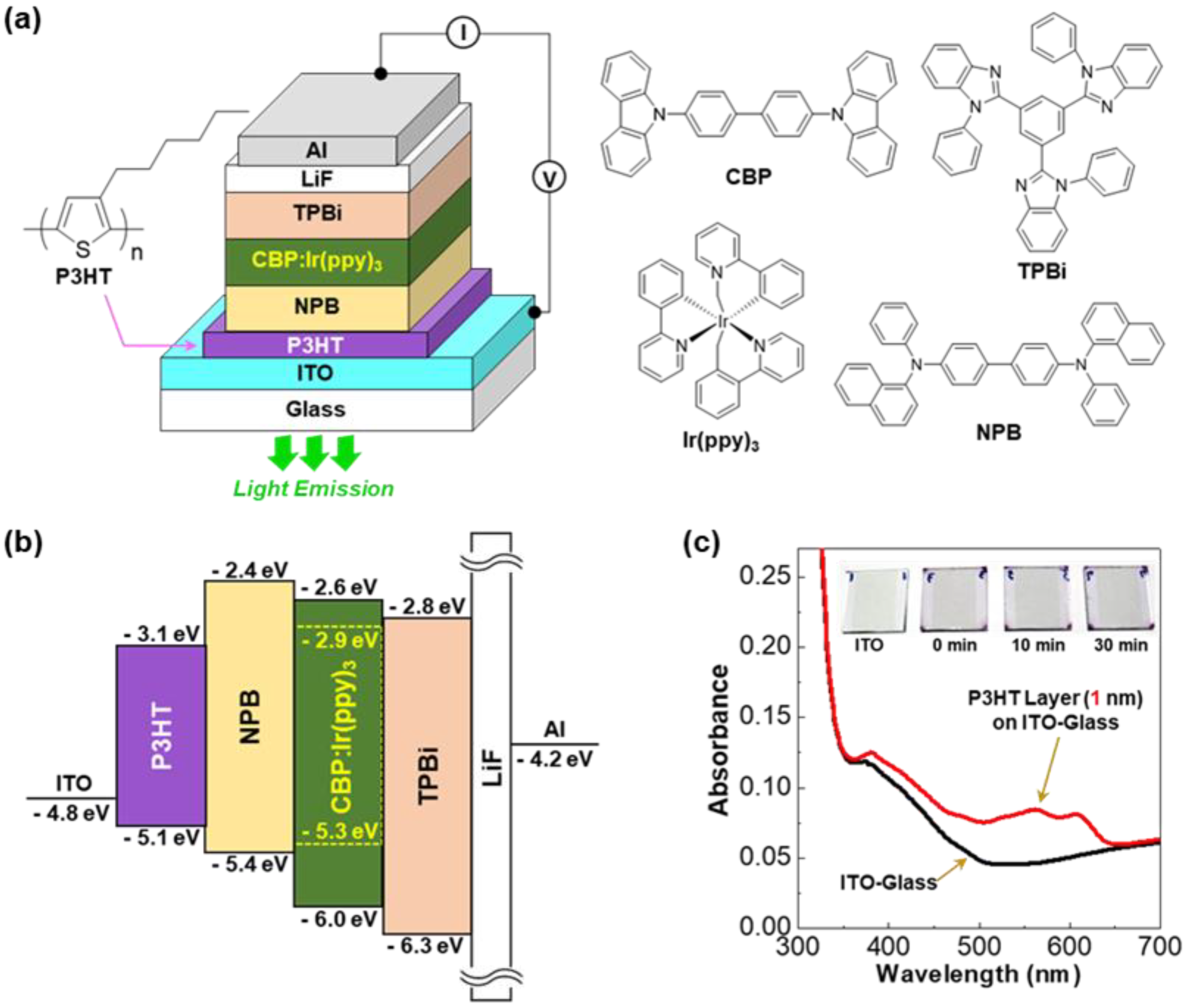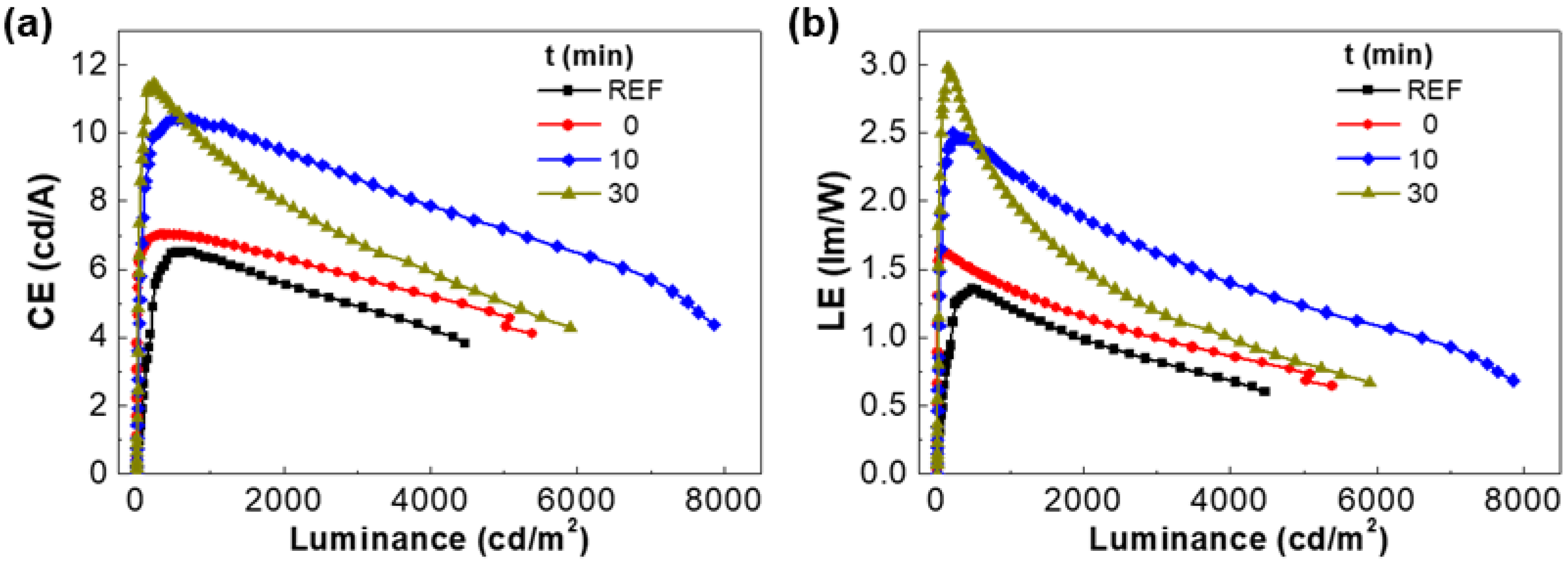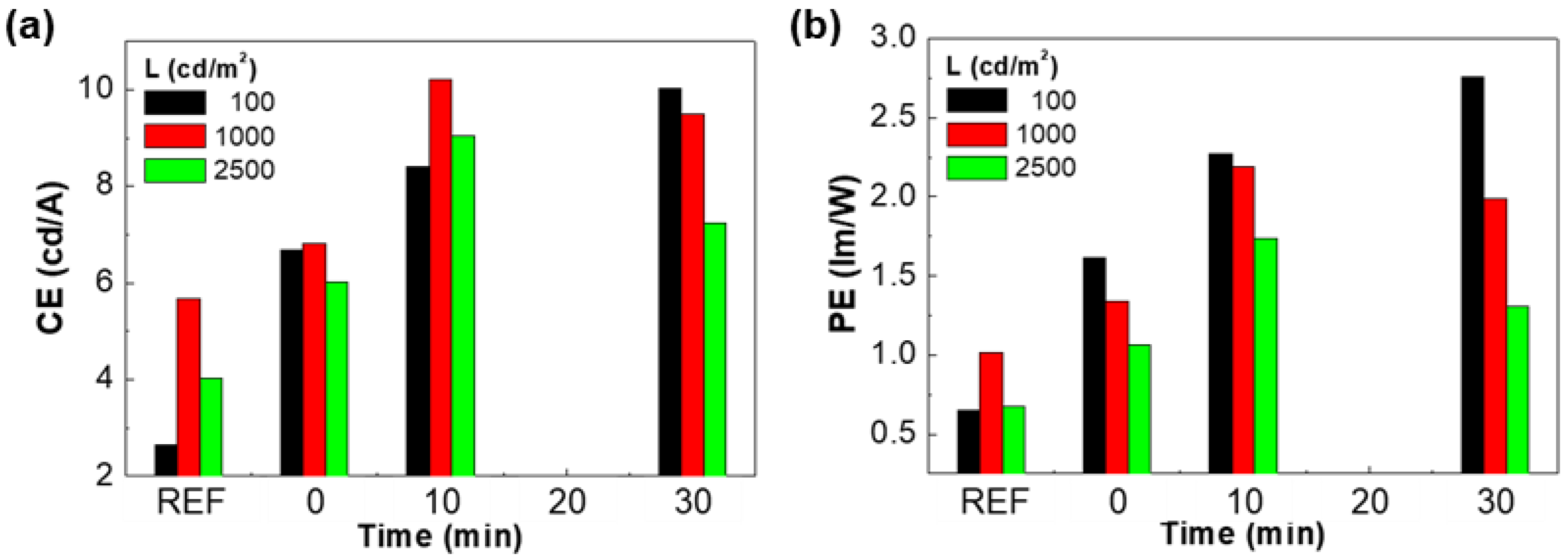Hole Injection Role of p-Type Conjugated Polymer Nanolayers in Phosphorescent Organic Light-Emitting Devices
Abstract
:1. Introduction
2. Materials and Methods
2.1. Materials and Solutions
2.2. Device and Film Fabrication
2.3. Measurements
3. Results and Discussion
4. Conclusions
Author Contributions
Funding
Conflicts of Interest
References
- Tang, C.W.; VanSlyke, S.A. Organic electroluminescent diodes. Appl. Phys. Lett. 1987, 51, 913–915. [Google Scholar] [CrossRef]
- Kim, Y.; Choi, D.; Moon, B.; Oh, E.; Lim, H.; Kwon, S.; Ha, C.-S. Controllable work function of Li:Al alloy nanolayers for organic light-emitting devices. Adv. Eng. Mater. 2005, 7, 1023–1027. [Google Scholar] [CrossRef]
- Kim, Y.; Ha, C.-S. Advances in Organic Light-Emitting Device, 1st ed.; TransTechPubn: Stafa-Zurich, Switzerland, 2008; pp. 1–140. [Google Scholar]
- Salehi, A.; Fu, X.; Shin, D.-H.; So, F. Recent advances in OLED optical design. Adv. Funct. Mater. 2019, 29, 1808803. [Google Scholar] [CrossRef]
- Sun, N.; Jiang, C.; Li, O.; Tan, D.; Bi, S.; Song, J. Performance of OLED under mechanical strain: A review. J. Mater. Sci. Mater. Electron. 2020, 31, 20688–20729. [Google Scholar] [CrossRef]
- Kim, Y.; Bae, K.H.; Jeong, Y.Y.; Choi, D.K.; Ha, C.-S. An electronically active molecularly doped polyimide hole injection layer for an efficient hybrid organic light-emitting device. Chem. Mater. 2004, 16, 5051–5057. [Google Scholar] [CrossRef]
- Zhang, Z.; Du, J.; Zhang, D.; Sun, H.; Yin, L.; Ma, L.; Chen, J.; Ma, D.; Cheng, H.-M.; Ren, W. Rosin-enabled ultraclean and damage-free transfer of graphene for large-area flexible organic light-emitting diodes. Nat. Commun. 2017, 8, 14560. [Google Scholar] [CrossRef]
- Tao, J.; Wang, R.; Yu, H.; Chen, L.; Fang, D.; Tian, Y.; Xie, J.; Jia, D.; Liu, H.; Wang, J.; et al. Highly transparent, highly thermally stable nanocellulose/polymer hybrid substrates for flexible OLED devices. ACS Appl. Mater. Interfaces 2020, 12, 9701–9709. [Google Scholar] [CrossRef]
- Kim, Y.; Oh, E.; Lim, H.; Ha, C.-S. Mixing effect of hole-injecting and hole-transporting materials on the performance and lifetime of organic light-emitting devices. Appl. Phys. Lett. 2005, 88, 043504. [Google Scholar] [CrossRef]
- Lim, S.K.J.; Rahamathullah, R.; Sarih, N.M.; Khairul, W.M. Tailoring tail-free nematogen of ethynylated-schiff base and its evaluation as solution-processable OLED emitting material. J. Lumin. 2018, 201, 397–401. [Google Scholar] [CrossRef]
- Kim, Y.; Han, K.; Ha, C.-S. Synthesis and characteristics of poly[N,N′-diphenyl-N,N″-bis(4-aminobiphenyl)-(1,1′-biphenyl)-4,4′-diamine pyromellitimide] as a hole injecting and transporting layer for hybrid organic light-emitting device. Macromolecules 2002, 35, 8759–8767. [Google Scholar] [CrossRef]
- Ding, L.; Dong, S.-C.; Jiang, Z.-Q.; Chen, H.; Liao, L.-S. Orthogonal molecular structure for better host material in blue phosphorescence and larger OLED white lighting panel. Adv. Funct. Mater. 2015, 25, 645–650. [Google Scholar]
- Kim, Y.; Choi, D.; Lim, H.; Ha, C.-S. Accelerated pre-oxidation method for healing progressive electrical short in organic light-emitting devices. Appl. Phys. Lett. 2003, 82, 2200–2202. [Google Scholar] [CrossRef]
- Keum, C.-M.; Liu, S.; Al-Shadeedi, A.; Kaphle, V.; Callens, M.K.; Han, L.; Neyts, K.; Zhao, H.; Gather, S.D.; Bunge, S.D.; et al. Tuning charge carrier transport and optical birefringence in liquid-crystalline thin films: A new design space for organic light-emitting diodes. Sci. Rep. 2018, 8, 699. [Google Scholar] [CrossRef] [Green Version]
- Cho, G.; Lee, H.; Woo, S.; Nam, S.; Kim, H.; Kim, Y. Diimide nanoclusters play hole trapping and electron injection roles in organic light-emitting devices. Nanoscale 2011, 3, 1073–1077. [Google Scholar] [CrossRef] [PubMed]
- Chulkin, P.; Vybornyi, O.; Lapkowski, M.; Skabara, P.J.; Data, P. Impedance spectroscopy of OLEDs as a tool for estimating mobility and the concentration of charge carriers in transport layers. J. Mater. Chem. C 2018, 6, 1008–1014. [Google Scholar] [CrossRef]
- Kok, C.; Doyranli, C.; Canimkurbey, B.; Mucur, S.P.; Koyuncu, S. Effect of thiophene linker addition to fluorene-benzotriazole polymers with the purpose of achieving white emission in OLEDs. RSC Adv. 2020, 10, 18639–18647. [Google Scholar] [CrossRef]
- Kim, Y.; Oh, E.; Choi, D.; Lim, H.; Ha, C.-S. Efficient blue organic light-emitting devices with charge carrier confining nanostructure formed by wide band gap molecule doping. Nanotechnol. 2003, 15, 149–153. [Google Scholar]
- Lee, W.H.; Kim, D.H.; Jesuraj, P.J.; Hafeez, H.; Lee, J.C.; Choi, D.K.; Bae, T.-S.; Yu, S.M.; Song, M.; Kim, C.S.; et al. Improvement of charge balance, recombination zone confinement, and low efficiency roll-off in green phosphorescent OLEDs by altering electron transport layer thickness. Mater. Res. Express 2018, 5, 076201. [Google Scholar] [CrossRef]
- Jesuraj, P.J.; Hafeez, H.; Kim, D.H.; Lee, J.C.; Lee, W.H.; Choi, D.K.; Kim, C.H.; Song, M.; Kim, C.S.; Ryu, S.Y. Recombination zone control without sensing layer and the exciton confinement in green phosphorescent OLEDs by excluding interface energy transfer. J. Phys. Chem. C 2018, 122, 2951–2958. [Google Scholar] [CrossRef]
- Kim, Y. Power-law-type electron injection through lithium fluoride nanolayers in phosphorescence organic light-emitting devices. Nanotechnol. 2008, 19, 355207. [Google Scholar] [CrossRef]
- Jesuraj, P.J.; Hafeez, H.; Rhee, S.H.; Kim, D.H.; Song, M.; Kim, C.S.; Ryu, S.Y. Effects of doping concentration and emission layer thickness on recombination zone and exciton density control in blue phosphorescent organic light-emitting diodes. ECS J. Solid State Sci. Technol. 2017, 6, R170. [Google Scholar] [CrossRef]
- Sanderson, S.; Vamvonuis, G.; Mark, A.E.; Byrn, P.L.; White, R.D.; Philippa, B.W. Unraveling exciton processes in Ir(ppy)3:CBP OLED films upon photoexcitation. J. Chem. Phys. 2021, 154, 164101. [Google Scholar] [CrossRef]
- Hamanaka, V.N.; Salsberg, E.; Fonseca, F.J.; Aziz, H. Investigating the influence of the solution-processing method on the morphological properties of organic semiconductor films and their impact on OLED performance and lifetime. Org. Electron. 2020, 78, 105509. [Google Scholar] [CrossRef]
- Liu, Z.; Tang, Z.; Liu, A.; Meng, G.; Yuan, X.; Tang, H.; Hu, D.; Xie, Z.; Wang, J.; Hou, L. Structure effect of carbazole-oxadiazole based organic small molecule hosts on the solution-processed phosphorescent OLEDs performance. J. Lumin. 2018, 195, 31–39. [Google Scholar] [CrossRef]
- Teng, J.-M.; Wang, Y.-F.; Chen, C.-F. Recent progress of narrowband TADF emitters and their applications in OLEDs. J. Mater. Chem. C 2020, 8, 11340–11353. [Google Scholar] [CrossRef]
- Huang, C.; Zhang, Y.; Zhou, J.; Sun, S.; Luo, W.; He, W.; Wang, J.; Shi, X.; Fung, M.-K. Hybrid tandem white OLED with long lifetime and 150 Lm W−1 in luminous efficacy based on TADF blue emitter stabilized with phosphorescent red emitter. Adv. Opt. Mater. 2020, 8, 2000727. [Google Scholar]
- Kim, K.-H.; Kim, J.-J. Origin and control of orientation of phosphorescent and TADF dyes for high-efficiency OLEDs. Adv. Mater. 2018, 30, 1705600. [Google Scholar] [CrossRef]
- Lim, H.; Cheon, H.-J.; Woo, S.-J.; Kwon, S.-K.; Kim, Y.-H.; Kim, J.-J. Highly efficient deep-blue OLEDs using a TADF emitter with a narrow emission spectrum and high horizontal emitting dipole ratio. Adv. Mater. 2020, 32, 2004083. [Google Scholar] [CrossRef]
- Song, X.; Zhang, D.; Lu, Y.; Yin, C.; Duan, L. Understanding and manipulating the interplay of wide-energy-gap host and TADF sensitizer in high-performance fluorescence OLEDs. Adv. Mater. 2019, 31, 1901923. [Google Scholar] [CrossRef]
- Jung, S.-W.; Kim, K.-S.; Park, H.-U.; Lampande, R.; Kim, S.K.; Kim, J.-H.; Han, C.-W.; Choi, H.-C.; Kwon, J.H. Patternable semi-transparent cathode using thermal evaporation for OLED display applications. Adv. Electron. Mater. 2021, 7, 2001101. [Google Scholar]
- Bae, S.K.; Choo, D.C.; Kang, H.S.; Yoo, K.H.; Kim, T.W. Transparent ultra-thin silver electrodes formed via a maskless evaporation process for applications in flexible organic light-emitting devices. Nano Energy 2020, 71, 104649. [Google Scholar] [CrossRef]
- Illmi, R.; Zhang, D.; Dutra, J.D.L.; Dege, N.; Zhou, L.; Wong, W.-Y.; Raithby, P.R.; Khan, M.S. A tris β-diketonate europium(III) complex based OLED fabricated by thermal evaporation method displaying efficient bright red emission. Org. Electron. 2021, 96, 106216. [Google Scholar] [CrossRef]
- Bae, H.-W.; Kim, S.K.; Lee, S.; Song, M.-G.; Lampande, R.; Kwon, J.H. Thermally evaporated organic/Ag/organic multilayer transparent conducting electrode for flexible organic light-emitting diodes. Adv. Electron. Mater. 2019, 5, 1900620. [Google Scholar] [CrossRef]
- Song, M.-G.; Kim, K.-S.; Yang, H.I.; Kim, S.K.; Kim, J.-H.; Han, C.-W.; Choi, H.-C.; Pode, R.; Kwon, J.H. Highly reliable and transparent Al doped Ag cathode fabricated using thermal evaporation for transparent OLED applications. Org. Electron. 2020, 76, 105418. [Google Scholar] [CrossRef]
- Wang, B.; Yang, H.; Zhang, Y.; Xie, G.; Ran, H.; Wang, T.; Fu, Q.; Ren, Y.; Sun, N.; Zhao, G.; et al. Highly efficient electroluminescence from evaporation- and solution-processable orange–red thermally activated delayed fluorescence emitters. J. Mater. Chem. C 2019, 7, 12321–12327. [Google Scholar] [CrossRef]
- Sim, H.; Kim, C.; Bok, S.; Kim, M.K.; Oh, H.; Lim, G.-H.; Cho, S.M.; Lim, B. Five-minute synthesis of silver nanowires and their roll-to-roll processing for large-area organic light emitting diodes. Nanoscale 2018, 10, 12087–12092. [Google Scholar] [CrossRef]
- Tsujimura, T.; Hakii, T.; Nakayama, T.; Ishidai, H.; Kinoshita, T.; Furukawa, S.; Yosida, K.; Osawa, K. Development of a color-tunable polychromatic organic-light-emitting-diode device for roll-to-roll manufacturing. J. Soc. Inf. Disp. 2016, 24, 262–269. [Google Scholar] [CrossRef]
- Tsujimura, T.; Hakii, T.; Noda, S. A color-tunable polychromatic organic-light-emitting-diode device with low resistive intermediate electrode for roll-to-roll manufacturing. IEEE Trans. Electron Devices 2016, 63, 402–407. [Google Scholar] [CrossRef]
- Sohn, S.; Kim, S.; Shim, J.W.; Jung, S.K.; Jung, S. Printed organic light-emitting diodes on fabric with roll-to-roll sputtered ITO anode and poly(vinyl alcohol) planarization layer. ACS Appl. Mater. Interfaces 2021, 13, 28521–28528. [Google Scholar] [CrossRef] [PubMed]
- Wei, M.C.; Zhuang, J.; Chen, Y.; Zhang, D.; Su, W.; Cui, Z. Highly air-stable electron-transport material for ink-jet-printed OLEDs. Chem. Eur. J. 2016, 22, 16576–16585. [Google Scholar] [CrossRef]
- Lin, T.; Sun, X.; Hu, Y.; Mu, W.; Sun, Y.; Zhang, D.; Su, Z.; Chu, B.; Cui, Z. Blended host ink for solution processing high performance phosphorescent OLEDs. Sci. Rep. 2019, 9, 6845. [Google Scholar] [CrossRef] [PubMed] [Green Version]
- Koizumi, H.; Ooshiro, K.; Soeda, K.; Homma, T. Effect of drying condition of emitting layer formed by ink-jet coating on optical property and film morphology of polymer-based organic light-emitting diodes. ECS J. Solid State Sci. Technol. 2019, 8, R36. [Google Scholar] [CrossRef]
- Chen, J.-X.; Tao, W.-W.; Xiao, Y.-F.; Wang, K.; Zhang, M.; Fan, X.-C.; Chen, W.-C.; Yu, J.; Li, S.; Geng, F.-X.; et al. Efficient orange-red thermally activated delayed fluorescence emitters feasible for both thermal evaporation and solution process. ACS Appl. Mater. Interfaces 2019, 11, 29086–29093. [Google Scholar] [CrossRef]
- Tsai, K.-W.; Hung, M.-K.; Mao, Y.-H.; Chen, S.-A. Solution-processed thermally activated delayed fluorescent OLED with high EQE as 31% using high triplet energy crosslinkable hole transport materials. Adv. Funct. Mater. 2019, 29, 1901025. [Google Scholar] [CrossRef]
- Peng, J.; Xu, X.; Feng, X.J.; Li, L. Fabrication of solution-processed pure blue fluorescent OLED using exciplex host. J. Limin. 2018, 198, 19–23. [Google Scholar] [CrossRef]
- Liu, S.; Yu, H.; Zhang, Q.; Qin, F.; Zhang, X.; Zhang, L.; Xie, W. Efficient ITO-free organic light-emitting devices with dual-functional PSS-rich PEDOT:PSS electrode by enhancing carrier balance. J. Mater. Chem. C 2019, 7, 5426–5432. [Google Scholar] [CrossRef]
- Gu, Z.-Z.; Tian, Y.; Geng, H.-Z.; Rhen, D.S.; Ethiraj, A.S.; Zhang, X.; Jing, L.-C.; Wang, T.; Xu, Z.-H.; Yuan, X.-T. Highly conductive sandwich-structured CNT/PEDOT:PSS/CNT transparent conductive films for OLED electrodes. Appl. Nanosci. 2019, 9, 1971–1979. [Google Scholar] [CrossRef]
- Wang, Z.; Gao, L.; Wei, X.; Zhao, M.; Miao, Y.; Zhang, X.; Zhang, H.; Wang, H.; Hao, Y.; Xu, B.; et al. Energy level engineering of PEDOT:PSS by antimonene quantum sheet doping for highly efficient OLEDs. J. Mater. Chem. C 2020, 8, 1796–1802. [Google Scholar] [CrossRef]
- Salsberg, E.; Aziz, H. Degradation of PEDOT:PSS hole injection layers by electrons in organic light emitting devices. Org. Electron. 2019, 69, 313–319. [Google Scholar] [CrossRef]
- Cameron, J.; Skabara, P.J. The damaging effects of the acidity in PEDOT:PSS on semiconductor device performance and solutions based on non-acidic alternatives. Mater. Horiz. 2020, 7, 1759–1772. [Google Scholar] [CrossRef] [Green Version]
- Tsai, C.-T.; Gottam, S.R.; Kao, P.C.; Perng, D.-C.; Chu, S.-Y. Improvement of OLED performances by applying annealing and surface treatment on electro-deposited CuSCN hole injection layer. Synth. Met. 2020, 269, 116537. [Google Scholar] [CrossRef]
- Zhang, X.; Zheng, Q.; Tang, Z.; Li, W.; Zhang, Y.; Xu, K.; Xue, X.; Xu, J.; Wang, H.; Wei, B. Tunable hole injection of solution-processed polymeric carbon nitride towards efficient organic light-emitting diode. Appl. Phys. Lett. 2018, 112, 083302. [Google Scholar] [CrossRef]
- Chin, B.D. Role of the polymeric hole injection layer on the efficiency and stability of organic light emitting diodes with small molecular emitters. J. Phys. D: Appl. Phys. 2008, 41, 215104. [Google Scholar] [CrossRef]
- Sato, S.; Ohisa, S.; Hayashi, Y.; Sato, Y.; Yokoyama, D.; Kato, T.; Suzuki, M.; Chiba, T.; Pu, Y.-J.; Kido, J. Air-stable and high-performance solution-processed organic light-emitting devices based on hydrophobic polymeric ionic liquid carrier-injection layers. Adv. Mater. 2018, 30, 1705915. [Google Scholar] [CrossRef]
- Roldao, J.C.; Batagin-Neto, A.; Lavarda, F.C.; Sato, F. Effects of mechanical stretching on the properties of conjugated polymers: Case study for MEH-PPV and P3HT oligomers. J. Polym. Sci. Part B Polym. Phys. 2018, 56, 1413–1426. [Google Scholar] [CrossRef]
- Kim, Y.; Choulis, S.A.; Nelson, J.; Bradley, D.D.C. Device annealing effect in organic solar cells with blends of regioregular poly(3-hexylthiophene) and soluble fullerene. Appl. Phys. Lett. 2005, 86, 063502. [Google Scholar] [CrossRef]






Publisher’s Note: MDPI stays neutral with regard to jurisdictional claims in published maps and institutional affiliations. |
© 2021 by the authors. Licensee MDPI, Basel, Switzerland. This article is an open access article distributed under the terms and conditions of the Creative Commons Attribution (CC BY) license (https://creativecommons.org/licenses/by/4.0/).
Share and Cite
Lee, S.; Kim, H.; Kim, Y. Hole Injection Role of p-Type Conjugated Polymer Nanolayers in Phosphorescent Organic Light-Emitting Devices. Electronics 2021, 10, 2283. https://doi.org/10.3390/electronics10182283
Lee S, Kim H, Kim Y. Hole Injection Role of p-Type Conjugated Polymer Nanolayers in Phosphorescent Organic Light-Emitting Devices. Electronics. 2021; 10(18):2283. https://doi.org/10.3390/electronics10182283
Chicago/Turabian StyleLee, Sooyong, Hwajeong Kim, and Youngkyoo Kim. 2021. "Hole Injection Role of p-Type Conjugated Polymer Nanolayers in Phosphorescent Organic Light-Emitting Devices" Electronics 10, no. 18: 2283. https://doi.org/10.3390/electronics10182283
APA StyleLee, S., Kim, H., & Kim, Y. (2021). Hole Injection Role of p-Type Conjugated Polymer Nanolayers in Phosphorescent Organic Light-Emitting Devices. Electronics, 10(18), 2283. https://doi.org/10.3390/electronics10182283





